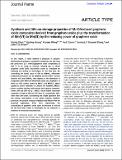Synthesis and lithium-storage properties of MnO/reduced graphene oxide composites derived from graphene oxide plus the transformation of Mn(vi) to Mn(ii) by the reducing power of graphene oxide
Abstract
In this report, a novel method is proposed to prepare MnO/reduced graphene oxide (rGO) composites via calcining the precursors (i.e. δ-MnO2/graphene oxide composites) at 500 °C in Ar using no external reducing gas, in which graphene oxide (GO) successfully serves as a reductant by releasing CO during its thermolysis for the first time. By controlling the initial ratios of GO to KMnO4, differently composed precursors can be obtained via the redox reaction between GO and KMnO4, then leading to the formation of composites with different MnO/rGO ratios and dispersion of MnO on the rGO surface (denoted as MGC1 and MGC2). When applied as an active material in lithium ion batteries, MGC1 shows excellent cycling performance and capacity retention. Under 100 and 200 mA g−1, MGC1 could deliver reversible capacities as high as 900 and 750 mA h g−1, respectively, after more than 100 cycles. Considering the simple operation and low energy consumption in the whole material synthesis processes, the present strategy is feasible and effective for practical application. Even more importantly, the reductibility of graphene oxide upon thermolysis is utilized for the first time, which is meaningful for its extension in synthesis of functional nanomaterials.
Citation
Zhao , G , Huang , X , Wang , X , Connor , P A , Li , J , Zhang , S & Irvine , J T S 2015 , ' Synthesis and lithium-storage properties of MnO/reduced graphene oxide composites derived from graphene oxide plus the transformation of Mn(vi) to Mn(ii) by the reducing power of graphene oxide ' , Journal of Materials Chemistry A , vol. 3 , no. 1 , pp. 297-303 . https://doi.org/10.1039/c4ta05376a
Publication
Journal of Materials Chemistry A
Status
Peer reviewed
ISSN
2050-7488Type
Journal article
Description
The authors acknowledge the financial support from the National Natural Science Foundation of China (21272236, 21225730, 21207136 and 91326202), the Ministry of Science and Technology of China (2011CB933700), the Jiangsu Provincial Key Laboratory of Radiation Medicine and Protection and the Priority Academic Program Development of Jiangsu Higher Education Institutions.Collections
Items in the St Andrews Research Repository are protected by copyright, with all rights reserved, unless otherwise indicated.

